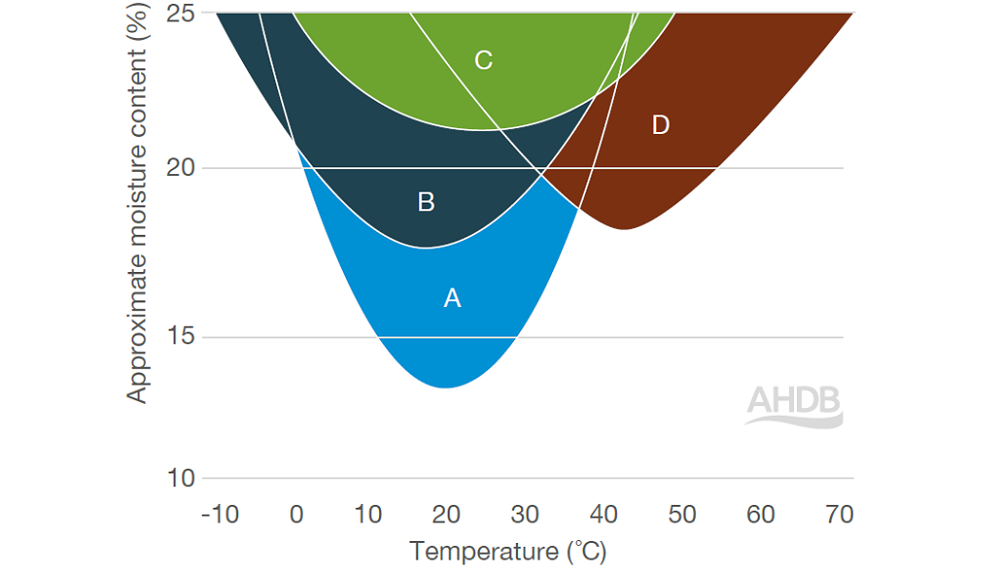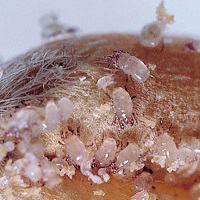- Home
- Knowledge library
- How the grain store environment affects pest (fungi, insects and mites) levels
How the grain store environment affects pest (fungi, insects and mites) levels
The main causes of spoilage in stored grain are fungi, insects and mites. Learn about the key pest species and how temperature and moisture content influence their growth and reproduction.
Fungi and mycotoxins in grain stores
Storage fungi can grow above around 14.5% and 7.5–8% moisture content (MC) on cereal grain and oilseed rape seed, respectively. The activity of each fungal group depends on a combination of moisture content and temperature.

The above chart shows the activity of four fungal groups at various temperatures and moisture contents.
- A – Aspergillus species, which may result in slow heating and damage germination
- B – Penicillium species, including those that produce mycotoxins
- C – Advanced decay/field fungi, such as Fusarium species and heating organisms
- D – Thermophilic fungi, which thrive at very high temperatures, such as those that occur in compost bins
The main fungus in UK stored grain is Penicillium verrucosum. This fungus is active at a relatively wide range of temperatures. When moisture content is at or above 18%, it can produce the mycotoxin ochratoxin A (OTA). EU regulations set permissible levels for OTA at 5 parts per billion (ppb) for cereals at intake, for human consumption. Where grain is stored above 18% MC, these levels can be exceeded in two weeks, if the temperature is sufficiently high. The principal method by which storage fungi can be controlled is through drying and cooling.
Warning: Do not sniff mouldy grain – spores can cause farmer’s lung.
Mycotoxins formed before harvest (e.g. by Fusarium species) are stable. Although likely to remain during storage, they do not increase.
Which fungal species are associated with in-field cereal mycotoxins?
Insects and mites in grain stores
There are three types of insect/mite associated with grain stores – grain-damaging species (primary pests), mould or hygiene-related species (secondary pests) and non-damaging or stray species.
Note: The direct physical presence of storage pests may also make the grain unacceptable to the customer.
Insects
Stored product insects are specialised for the grain storage environment. They can breed at relatively low temperatures and moisture contents. Even a single insect in a 1 kg grain sample may represent a potentially serious infestation. In general, cereals are more susceptible to insect attack than oilseed rape.
Primary storage pests can survive on grain residues from the previous harvest and will infest new grain as it is placed into the store. As a result, good store hygiene helps reduce insect presence and infestation problems.
Common primary species are the grain weevil (Sitophilus granarius), saw-toothed grain beetle (Oryzaephilus surinamensis) and the rust-red grain beetle (Cryptolestes ferrugineus) – pictured left to right, below.
 Crown Copyright
Crown Copyright
Weevils breed at relatively low temperatures. Grain weevils develop inside the grain, making early detection difficult. As it feeds, the larva hollows out the inside of the grain. When left unmanaged, this can cause ‘hotspots’, where activity of the last larval stage raises grain temperature locally. As it damages grain (including when it exits the grain as an adult), it makes it easier for other pests to enter. Further temperature increases encourage rust-red grain beetles.
Secondary insect pests, such as the foreign grain beetle, spider beetles and booklice, only damage poorly conditioned grain and are primarily fungus feeders.
Mites
At least twelve mite species infest UK stored grain. The most common are Acarus, Tyrophagus and Lepidoglyphus species. However, species identification is a task for a specialist. Storage mites are small (<0.5 mm long) and just visible to the naked eye, seen as white specks or pink dust moving on the grain surface or in sievings. They may accumulate in traps at the grain bulk’s surface or in bait bags, mite traps and floor traps in empty stores.
Mites breed rapidly under favourable conditions. However, they are prone to water loss and die at low relative humidity (rh). Most species do not breed below 65% rh. Numbers at the surface may decline naturally, if the surface moisture content falls below 65% rh in the spring.
Mites can cause direct damage to the grain by eating the germ or hollowing out oilseeds and may also cause taint. They also cause allergic reactions, although only usually associated with large populations of mites. Predatory mites may also be present, especially where there are large populations of storage mites.
 Crown Copyright
Crown Copyright
How to identify insects and mites
Our website includes images of over 50 insect and mite species that may occur in grain stores. It covers the primary insect pests, as well as secondary pests, mites, moths and booklice. Correct identification is important to determine the appropriate management response.
Topics:
Sectors:
Tags:

